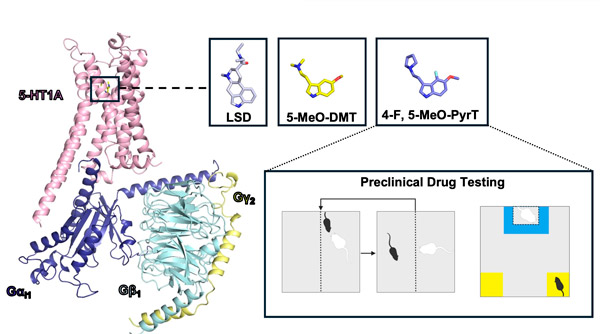Psychedelics may have therapeutic benefits through their effects on serotonin receptors
最近審查:14.06.2024

Researchers at the Icahn School of Medicine at Mount Sinai have shed light on the complex mechanisms by which a class of psychedelic drugs binds to and activates serotonin receptors to produce potential therapeutic effects in patients with neuropsychiatric disorders such as depression and anxiety. p>
In a study published in the journal Nature, the team reported that certain psychedelic drugs interact with an understudied member of the serotonin receptor family in the brain, known as 5-HT1A, to induce therapeutic benefits in animal models.
"Psychedelics such as LSD and psilocybin are in clinical trials with promising early results, although we still do not understand how they interact with various molecular targets in the brain to produce their therapeutic effects," says first author Audrey Warren, PhD candidate at the Icahn Graduate School of Biomedical Sciences at Mount Sinai.
"Our study highlights for the first time how serotonin receptors, such as 5-HT1A, likely modulate the subjective effects of psychedelic experiences and also play a potentially key role in their clinically observed therapeutic outcome."
LSD and 5-MeO-DMT, a psychedelic found in the secretions of the Colorado River toad, are known for their hallucinogenic effects through the serotonin 5-HT2A receptor, although these drugs also activate 5-HT1A, a proven therapeutic target for the treatment of depression and anxiety.
Working closely with co-author Dalibor Sames, Ph.D., a professor in the Department of Chemistry at Columbia University, the team synthesized and tested 5-MeO-DMT derivatives in cell signaling assays and cryo-electron microscopy to identify the chemical components which are most likely to cause preferential activation of 5-HT1A over 5-HT2A.
This approach led to the discovery that a compound called 4-F,5-MeO-PyrT was the most selective for 5-HT1A in the series. Lyonna Parise, Ph.D., an instructor in the laboratory of Scott Russo, Ph.D., director of the Center for Affective Neuroscience and the Icahn Brain and Body Research Center at Mount Sinai, then tested this lead compound in a mouse model of depression and showed that 4- F,5-MeO-PyrT had an antidepressant effect that was effectively modulated through 5-HT1A.
"We were able to fine-tune the 5-MeO-DMT/serotonin platform to produce maximum activity at the 5-HT1A interface and minimal activity at the 5-HT2A interface," explains senior author Daniel Wacker, Ph.D., assistant professor of pharmacological sciences and Neurosciences at Icahn at Mount Sinai.
"Our findings suggest that receptors other than 5-HT2A not only modulate the behavioral effects resulting from psychedelics, but may also contribute significantly to their therapeutic potential. In fact, we were pleasantly surprised by the strength of this contribution in 5- MeO-DMT, which is currently being tested in several clinical trials for the treatment of depression, we believe that our research will lead to a better understanding of the complex pharmacology of psychedelics, which involve many types of receptors."

Mount Sinai scientists took detailed photographs of the serotonin receptor and clinically proven drug target 5-HT1A using cryo-electron microscopy to show how the psychedelics LSD and 5-MeO-DMT, as well as the 5-HT1A-selective derivative 5 -MeO-DMT (4-F, 5-MeO-PyrT) bind. The team also found that 4-F,5-MeO-DMT exerts antidepressant effects in mouse models via 5-HT1A, potentially contributing to the therapeutic effects of psychedelics observed in clinical studies. Authors: Pharmacology Ph.D. Audre Warren and Pharmacology and Neuroscience Associate Professor Danielle Wacker.
Researchers hope their breakthrough findings will soon lead to the development of new psychedelic-based drugs that do not have the hallucinogenic properties of current drugs. Fueling expectations is the discovery that their lead compound, the most selective 5-HT1A analogue 5-MeO-DMT, showed antidepressant effects without 5-HT2A-related hallucinations.
Another immediate goal for scientists is to study the effects of 5-MeO-DMT in preclinical models of depression (given the limitations of research involving psychedelic drugs, studies with 5-MeO-DMT derivatives have been limited to animal models).
“We have demonstrated that psychedelics have complex physiological effects spanning many different receptor types,” emphasizes first author Warren, “and are now poised to build on this discovery to develop improved therapeutics for a wide range of mental disorders.”

